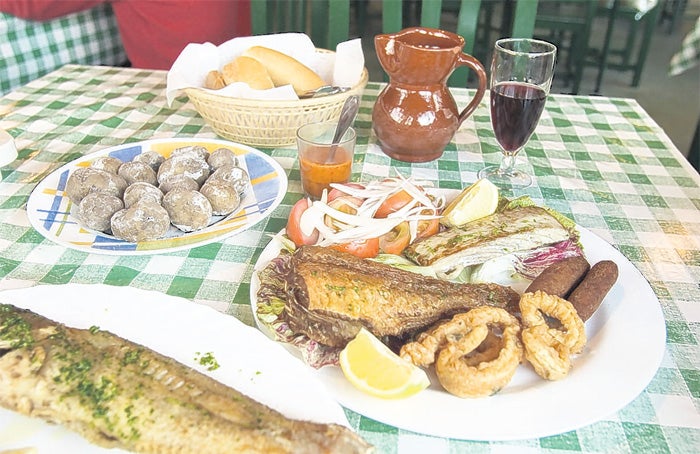The culinary delights of La Gomera
Cuisine that’s an island apart

Your support helps us to tell the story
As your White House correspondent, I ask the tough questions and seek the answers that matter.
Your support enables me to be in the room, pressing for transparency and accountability. Without your contributions, we wouldn't have the resources to challenge those in power.
Your donation makes it possible for us to keep doing this important work, keeping you informed every step of the way to the November election

Andrew Feinberg
White House Correspondent
Talk of different regional cuisines sounds out of place on an island 15 miles wide but, as I coaxed my hesitant little rental car around the precipitous hairpin bends that separate the dusty sun-baked coast from misty interior forests, it quickly became apparent that La Gomera varies wildly over a small area. Island gastronomy mirrors the geography and the rugged remoteness also tends to keep everything firmly off the beaten track and old-fashioned. But in the context of today's trend for simple, fresh, local, organic and free-range food, things have travelled full-circle, with island cookery now highly fashionable.
Naturally, La Gomera's coastal settlements specialise in fish and seafood, with freshly grilled tuna steaks a staple, and generally best enjoyed in bare-bones places on harbours and seafronts, where menus usually vary with the day's catch. As I discovered on arrival in San Sebastián, La Gomera's main town, the Casa del Mar (00 34 922 870 320) on Paseo de Fred Olsen 1, opposite the marina, has what must be the island's largest selection of fish and seafood. It serves an excellent cazuela, a herb-heavy fish stew that takes almost an hour to prepare. It's served with gofio, a wheat, maize or barley flour that's been in the Canarian diet since before the Spanish conquest. Aboriginal Guanche goatherds would take pouches of the stuff into the hills, and use stream water to make dough-ball snacks. These days gofio generally replaces bread and is sprinkled on soups and stews; most rustic bistros have pots of it on every table. Another good basic harbour-side eatery is El Puerto (00 34 922 805 224) in Valle Gran Rey, whose grilled fish platter for two people (€17) is its wonderfully varied speciality.
Inland, other ingredients have traditionally formed the backbone of cuisine. Cress soup is a refreshing mainstay, while chicken, goat or rabbit form the basis of most main dishes, such as rancho canario, a chunky stew. Elsewhere these meats are enhanced by rich, tangy and often garlicky sauces, such as the tomato salmorejo sauce that generally smothers rabbit. Such dishes are best enjoyed in fairly basic upland bars and restaurants, such as El Tambor (00 34 922 800 709), beside the Park Visitor Centre for Garajonay National Park, which protects the laurel forest at the island's centre.
Better still, just beyond the south-western edge of the park in Las Hayas, La Montaña (00 34 922 804 077; efigenianatural.com ) is known for its superb vegetarian wholefood cuisine. Stews are mainly served here, and it's a true slow-food experience. You'll likely have to wait for the ingredients to be picked as well as cooked – while you nibble salads and local goats' cheeses and sup the hearty local wine.
Both along the coast and up in the mountains, many dishes come with papas arrugadas, delicious little Canarian new potatoes left in their skin and boiled dry in salty water, until their dark wrinkles are coated white. They always come with mojo, a local dip, usually served in a pair, with the fiery and peppery red rojo balanced by the soothing, coriander-heavy verde. Their quality is often considered the measure of a Canarian restaurant, so the finest closely guard their recipes: in La Gomera, these include the Marqués de Oristano (00 34 922 141 541) on Calle del Medio 24, in San Sebastián, which dishes up a superb selection of tapas in an 18th-century house and gives local food a gourmet twist: rabbit comes in marmalade; lobster with melon and mint. The Mirador de Palmarejo (00 34 922 805 868) is another top option, though its imaginative local menu needs to compete with the restaurant's novel design: the work of the Canarian artist César Manrique, it's built into the side of a cliff and offers dizzying views of the vast canyon of Valle Gran Rey.
When it's time to leave, there's no shortage of excellent gastronomic souvenirs on La Gomera: Mojo from local delis is an obvious choice, but better still is the unusual molasses-like Miel de Palma or palm honey. This ends up in many island desserts, as well as in the tangy liqueur, Gomeron. The honey is the product of the Gomeran palm, of which only around 2,000 trees remain – each protected by law –which provides sap only every few years. This makes harvesting a real skill and the syrup expensive, though you can get a good deal at the Wednesday or Saturday farmers' market in San Sebastián. But be warned: the honey's fiendish addictiveness (it's brilliant on ice cream) might be the start of an expensive habit: it's hard to find outside La Gomera and near-impossible to track down outside the Canaries. Perhaps leaving you with no choice other than returning to this unusual isle.
Subscribe to Independent Premium to bookmark this article
Want to bookmark your favourite articles and stories to read or reference later? Start your Independent Premium subscription today.
Join our commenting forum
Join thought-provoking conversations, follow other Independent readers and see their replies
Comments